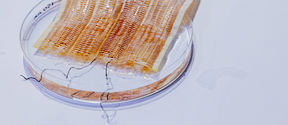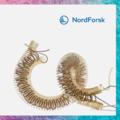More about the project:
Electronic textiles, e-textiles or smart textiles are terms that are interchangeably used for digitally enhanced fabrics. The electronic components in e-textiles augment their aesthetic appeal or enable new functionality, like wearable electronics. Common problems hindering the commercialization of current e-textiles are durability (e.g., brittleness), user discomfort due to integrated bulky electronics, and sustainability. In AI-yarn, we address these challenges by developing novel biomaterial-based yarns for e-textiles. This will be achieved by combining different biodegradable and/or biobased materials (i.e. cellulose, potato viruses, PLA) for a fully bio-based assembly line for electrically active yarns.
With machine learning, namely Bayesian optimization, we optimize filaments' and yarns' functional properties starting from the main variables that affect them. This approach allows to save time as the experiments suggested by the algorithm are specifically aimed to find the global maximum (or minimum), using a probabilistic function in the desired variables-space.
AI-yarn will produce novel biomaterial yarns and deliver the first use-case of artificial intelligence (AI) for bioinnovations.
Interdisciplinary collaboration
In AI-yarn, two young PIs combine their complementary expertise in biomaterials and computer science for the first time in a funded project. In this interdisciplinary project, machine learning techniques facilitate and accelerate biomaterials synthesis. Machine learning unlocks unprecedented opportunities for materials and process optimization, unveils previously unseen correlations between materials characteristics and functional properties, and aids in the discovery of new compounds.
Scientific, societal and bioinnovative impact
To the best of our knowledge, AI-yarn would deliver the first functional biohybrid material for e-textiles and provide sustainable options of smart textiles. Scientifically, AI-yarn establishes a new paradigm of AI-guided biomaterials research and accelerated materials development.
As a fundamental interdisciplinary project, AI-yarn enables completely bio-based functional conductive and triboelectric yarns and fabrics. We will also create an alternative for Ag-coated conductive yarns commonly applied in current e-textiles. We believe that our biohybrid platform will significantly improve the flexibility and durability of Ag nanowire-based conductive yarns. This opens new opportunities for the ever-growing application areas of e-textiles.


















